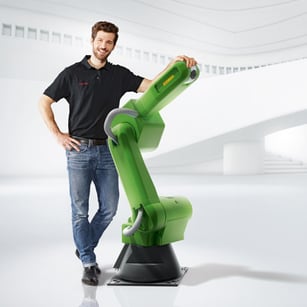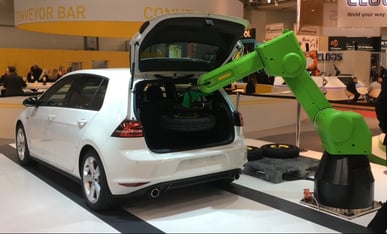Fanuc's First Collaborative Robot: CR-35iA

Posted on May 05, 2015 in Collaborative Robots
3 min read time
A couple of months ago I wrote an article about the ''Green Fanuc''. The robot has been demonstrated at different shows and seemed to be promising in terms of performance and also in the difference it can make in the robotic market. Well, I was not wrong. Fanuc recently announced the ''Green Fanuc'' as part of their product line. Let's see what this robot is all about.
The new Fanuc robot is called the CR-35iA, which stands for Collaborative Robot with a 35 kg payload!! Yes, 35 kg payload. That is a lot! With Universal Robots UR10 having a payload of 10 kg, the new CR-35iA is 3.5 time stronger than the UR10. With all other collaborative robot manufacturers building smaller robots with smaller payloads, why would Fanuc come out with such a big robot?
Green Fanuc CR-35iA in the Collaborative Market

Experts have been telling everyone that collaborative robotics is the next big thing. However, all these robots have been relatively small and were working in a small area. This means that they are limited in the number of applications they can be used for. By increasing the payload and the reach of a collaborative robot, a wider range of applications just got unlocked. With all the same safety requirements that apply to the other collaborative robots, the Green Fanuc (I love this name) can do a lot more.
Another market aspect to consider is that most collaborative robots are designed to be transported from one work station to another, which is not the case for the CR-35iA. It is relatively heavy and has a pedestal that is designed to be fixed to the ground. Which leads to a new kind of collaborative robot, one that is designed to do a single (or very limited) operation. This kind of application can still be done alongside humans and be safe. However, fixing the robot limits the flexibility of the robot. Yes, you can still reprogram the robot using hand guided programming to change it from one path to another, but you can't use the robot for packaging, move it and use it for machine tending, things that could be done using a UR10 or Sawyer for example.
What Is so Cool About This Industrial Robot...
To be honest I am really stoked to see this kind of robot emerging. Since a lot of collaborative applications needed a bigger payload, this was just the missing piece to increase the popularity of collaborative robots. In addition to its payload, the CR-35iA has good repeatability and a long reach. The robot seems to target integration with automotive assembly lines, machine tending applications, metalworking and packaging, but could probably be used for much more.

Specifications:
- Payload: 35 kg
- Reach: 1,813 mm
- Repeatability: +/- 0.08 mm
- Wrist Rotation : 900 deg.
The robot can be hand-guided which is similar to all the other collaborative robots on the market. It has a compliant soft rubber skin that reduces the force of an impact with a human. It seems like the robot is based on a M-20iA/35M with an additional cover to cover pinch points and reduce the presence of sharp edges. The force feedback is embedded in each joints and this is why the robot can be considered collaborative. This is a great option for Fanuc since they already have good hardware and software with their M-20iA/35M, they simply added force sensors, a rubber cover and fine tuned the software to create a collaborative robot. Other companies are also doing this to come out with good/safe robots.
Advantages:
- Hand-Guiding
- Soft rubber skin
- Easy to fit all Fanuc software and sensors
The robot is then a good combination of the positive advantages of industrial robots, but with safety devices that allow for safe collaboration. In my opinion, this is what is shaping the robot market today, collaborative robots helping humans with various tasks, in either small or heavy applications. A lot of interesting options are also available for these new collaborative robots, such as cameras and simulation software.
This robot is sill not part of our eBook on collaborative robots, but it should get there sometimes soon. In the mean time you can still take a look at the other collaborative robot models that are available on the market.







Leave a comment